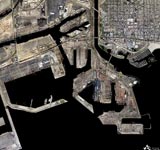
Port of Long Beach: "Clean Before We Grow"
- By L.K. Williams, EPonline
- Aug 04, 2008
 As a "real estate leasing company," the Port of Long Beach, Calif., does not make pollution but does own it -- in the sense that the port is ensuring that tenants and users do their part in meeting environmental standards.
As a "real estate leasing company," the Port of Long Beach, Calif., does not make pollution but does own it -- in the sense that the port is ensuring that tenants and users do their part in meeting environmental standards.
That's a tall order. The port oversees 3,230 acres, some of which were contaminated when first purchased, and 22 miles of waterfront. The privately owned-mobile sources of air pollution include:
• yard hostlers and gantry cranes working in the tenant-operated terminals,
• trains traveling by on-dock rail,
• heavy-duty trucks carrying containerized cargo to and from the terminals, and
• marine vessels, primarily from Asia, making about 5,300 yearly vessel calls.
Port staff members refer to Robert Kanter as the father of the Green Port Policy. The policy, adopted in 2005 by the Board of Harbor Commissioners, is all about protecting the community, promoting sustainability, engaging and educating the community about environmental programs, and employing the best technology to avoid and reduce environmental impacts. The Port of Long Beach has set itself up to be a leader in environmental stewardship.
Kanter, managing director of Environmental Affairs and Planning, came on board in the early 1990s to deal with a "pressing water quality-dredging issue." The port had acquired an old oil field and a naval complex with the understanding that it would clean up contamination there. Having remediated oil sumps, semivolatile organic compounds, metals, and polycydic aromatic hydrocarbons, the port now has valuable property it can put to use. But that property lease as well as a major project to redevelop the Middle Harbor may have to wait. "We have linked environmental improvements with infrastructure," said Richard Steinke, executive director of the port. "We have to clean before we grow."
Risky business
According to Art Wong, port assistant communications director, the organization has no real environmental regulatory authority. "We can negotiate green leases with environmental covenants," he explained. In a lease agreement negotiated in 2006, terminal operator K-Line agreed to have the port install plug-in facilities, known as cold-ironing, for marine vessels. That means K-Line will have to retrofit its vessels, but both the port and the company will be cutting diesel emissions at berth.
Other long-term leases will be up for renewal over the next few years. Sometimes terminal operators seek renegotiation for market reasons. So the potential to green the port is strong, however, "this has been a difficult year for companies, clients may choose not to come to this port," Wong said.
Banking on the opposite outcome, the Port of Long Beach has spent about half of its $1 billion 2007 budget on environmental upgrades, believing from the top down that it will soon be the model for shipping centers worldwide.
Environmental roles
According to Kanter, several programs have grown out of the policy, affecting each of the players. For example, tenants have been trained to sweep frequently and use drip pans to catch engine oil in order to prevent stormwater runoff into San Pedro Bay. Some of them are using electric gantry cranes and cleaner hostlers.
Anthony Otto, president of Long Beach Container Terminal Inc., operates his yard on Pier F. "Several years back, we saw issues rising and partnered with the Port of Long Beach," he said.
His company, which is owned by the C.Y. Tung Group, has installed diesel oxidation catalysts on yard equipment, uses a low-sulfur blended fuel, and is testing LNG yard hostlers. "We were the first to install a Vycon REGEN system to the RTGs (rubber tired gantry cranes). The technology uses a flywheel to store energy until the power demand is greatest, he explained.
"We hope that with the technology advancement program, we will be able to deploy a hybrid crane--that would mean a 70-80 percent emissions reduction."
Why is Otto so eager to do these things? "Lots of technology makes sense," he said. "Hybrid works for the environment and energy. If we can make it work, this is good."
Otto said in the next several years he expects to earn a return on his investment through the fuel savings afforded by the flywheel technology.
Although his business is "down 20 percent right now," Otto said his company experienced "six years of good times," and business is projected to double over the next 10 years.
Green pride
One of the most successful Green Port Policy programs -- with now close to 95 percent participation -- is the Green Flag program. Just by slowing marine vessels down to 12 knots within 20 miles of the port, companies reduce nitrogen oxide emissions significantly. The vessels are tracked by radar and a software program makes their progress available to vessel crews. To encourage participation, the port provides green flags to fly on "winning" vessels and lowers terminal dockage fees.
Through its technology advancement program, the port has encouraged the testing of liquefied natural gas locomotives, hybrid tugboats, heavy-duty electric and LNG trucks, and even a "sock on the stack" to reduce marine vessel emissions while docked at the port.
Although the port is investing heavily in its green programs, it does not seem naïve or unrealistic about the job ahead. "We will have some uncomfortable moments as we go through this process," Steinke remarked.
About the Author
L.K. Williams is the Environmental Group Editor of 1105 Media.